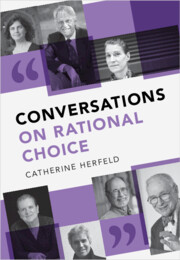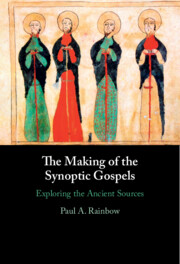Refine search
Actions for selected content:
98 results

Conversations on Rational Choice
-
- Published online:
- 27 December 2025
- Print publication:
- 31 January 2026
Chapter 9 - Partition of India
- from Part II - Separate Paths
-
- Book:
- Historical Trauma
- Published online:
- 20 November 2025
- Print publication:
- 04 December 2025, pp 254-268
-
- Chapter
- Export citation
Class, Relationships, and the Art of Historical Imagination: An Oral History Interview with Daniel James
-
- Journal:
- The Americas , First View
- Published online by Cambridge University Press:
- 26 November 2025, pp. 1-28
-
- Article
- Export citation
‘For me, it was life-changing’: the Italian contact zone of occupation and the encounter with otherness in oral history recollections
-
- Journal:
- Modern Italy , First View
- Published online by Cambridge University Press:
- 21 November 2025, pp. 1-15
-
- Article
-
- You have access
- Open access
- HTML
- Export citation
14 - Fortuna Fortes Adiuvat
-
-
- Book:
- Law and Constitutional Change
- Published online:
- 26 September 2025
- Print publication:
- 16 October 2025, pp 256-274
-
- Chapter
-
- You have access
- Open access
- HTML
- Export citation
Us and Them: Disability Ethics, Oral History and Inclusive Praxis in the Reuse of Asylum Photography
- Part of
-
- Journal:
- Transactions of the Royal Historical Society , First View
- Published online by Cambridge University Press:
- 23 September 2025, pp. 1-31
-
- Article
-
- You have access
- Open access
- HTML
- Export citation
Shona Oral Traditions and the Quest for Cognitive Justice: What Shona Public Humanities Contribute to a World in Crisis
- Part of
-
- Journal:
- Public Humanities / Volume 1 / 2025
- Published online by Cambridge University Press:
- 04 September 2025, e135
-
- Article
-
- You have access
- Open access
- HTML
- Export citation
Chapter 15 - The Strange Case of a “Lost” Dramatic Performance
- from Part IV - Transcreating
-
-
- Book:
- Latinx Literature in Transition, 1444–1886
- Published online:
- 06 August 2025
- Print publication:
- 17 July 2025, pp 341-362
-
- Chapter
- Export citation
16 - Ana María Cetto Kramis: Light in Quantum Mechanics and Open Science
-
-
- Book:
- Women in the History of Quantum Physics
- Published online:
- 02 July 2025
- Print publication:
- 19 June 2025, pp 430-459
-
- Chapter
- Export citation
8 - Mapping the Holocaust
-
-
- Book:
- The Cambridge History of the Holocaust
- Published online:
- 16 May 2025
- Print publication:
- 12 June 2025, pp 152-173
-
- Chapter
- Export citation
9 - Archiving the Holocaust
-
-
- Book:
- The Cambridge History of the Holocaust
- Published online:
- 16 May 2025
- Print publication:
- 12 June 2025, pp 174-197
-
- Chapter
- Export citation
Creating Space: Methods for Intergenerational Engagement
- Part of
-
- Journal:
- Public Humanities / Volume 1 / 2025
- Published online by Cambridge University Press:
- 02 May 2025, e96
-
- Article
-
- You have access
- Open access
- HTML
- Export citation
Spirit Cave Resilience: How Do We Explain a 10,000-Year Continuity?
-
- Journal:
- American Antiquity / Volume 90 / Issue 2 / April 2025
- Published online by Cambridge University Press:
- 15 April 2025, pp. 243-262
- Print publication:
- April 2025
-
- Article
-
- You have access
- Open access
- HTML
- Export citation
Pacific Islanders Experience the Pacific War: Informants as Historians and Story Tellers
-
- Journal:
- Asia-Pacific Journal / Volume 15 / Issue 20 / October 2017
- Published online by Cambridge University Press:
- 14 March 2025, e1
-
- Article
-
- You have access
- Open access
- Export citation
The Evolution of the Irish 12.5 Percent Corporate Tax Rate: An Oral History
-
- Journal:
- Enterprise & Society , First View
- Published online by Cambridge University Press:
- 17 February 2025, pp. 1-25
-
- Article
-
- You have access
- Open access
- HTML
- Export citation
Written Out of History: Collective Reflection with Oral History Narrators on Pakistan’s Women Constitution-Makers
- Part of
-
- Journal:
- Transactions of the Royal Historical Society / Volume 3 / December 2025
- Published online by Cambridge University Press:
- 13 January 2025, pp. 327-342
- Print publication:
- December 2025
-
- Article
-
- You have access
- Open access
- HTML
- Export citation
Perspectives on Psychometrics Interviews with 20 Past Psychometric Society Presidents
-
- Journal:
- Psychometrika / Volume 86 / Issue 1 / March 2021
- Published online by Cambridge University Press:
- 01 January 2025, pp. 327-343
-
- Article
-
- You have access
- Open access
- HTML
- Export citation
5 - The Tradition of the Apotheosis in North America
-
- Book:
- Fallen From Heaven
- Published online:
- 12 December 2024
- Print publication:
- 19 December 2024, pp 191-224
-
- Chapter
- Export citation

The Making of the Synoptic Gospels
- Exploring the Ancient Sources
-
- Published online:
- 21 November 2024
- Print publication:
- 28 November 2024
9 - Insular Varieties of English in Britain
- from Part I - English
-
-
- Book:
- Language in Britain and Ireland
- Published online:
- 17 October 2024
- Print publication:
- 31 October 2024, pp 238-248
-
- Chapter
- Export citation
